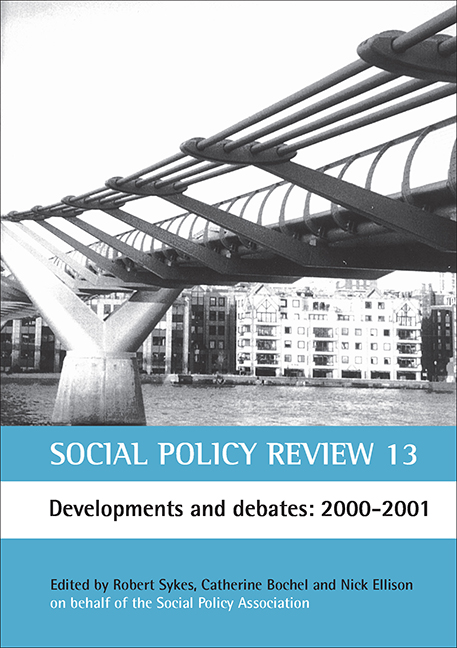Part Three - Historical and conceptual developments
Published online by Cambridge University Press: 20 January 2022
Summary
The four chapters in this final section explore a range of issues that are broadly historical and/or theoretical in nature. In each case, the contributors either ‘push the boundaries’ of ‘traditional’ social policy in ways that encompass reinterpretations of historical events and issues, or examine the implications of newly emerging phenomena for our understanding of the role and nature of contemporary welfare.
Jean Carabine’s chapter on sexuality and the New Poor Law (Chapter Thirteen) provides a Foucauldian reading of a landmark example of early social legislation which foregrounds sexuality as a central ‘discourse’. As Carabine suggests, social policy conveys “messages about what is acceptable and appropriate (hetero)sexuality as well as what is inappropriate and unacceptable sexual practices and relationships”, and she examines this ‘normalisation process’ in relation to bastardy, promiscuity and marriage. Importantly, of course, Carabine notes that traces of certain discourses, the origins of which can be traced to the NPL, have a resonance in 20th- and 21st-century social policy – the contemporary treatment of lone mothers being one example.
Bridging history and theory, Hewitt’s chapter (Chapter Twelve) examines the role played by theories of human nature in the contemporary history of welfare reform. Identifying four ideal typical models upon which social democratic and neo-liberal accounts variously draw, Hewitt suggests that the (discrepant) elements of these models were held together – sutured – by the device of the National Minimum, the role of which was best exemplified in the 1942 Beveridge Report. The key argument, however, is that whereas both social democrats and neo-liberals “held coherent social policy discourses based on a range of different component models of human nature”, New Labour’s project as defined by the nebulous ‘Third Way’ lacks a coherent conception of human nature. Although Labour’s social policy evokes elements of earlier models of human motivation, the party has evolved no suturing principle capable of holding together these potentially centrifugal components.
The two other chapters by Nixon and Keeble (Chapter Ten), and Fitzpatrick (Chapter Eleven), move away from historical concerns to an examination of two concerns which hold important implications for contemporary social policy. Nixon and Keeble assess the impact of the new communication technologies and ask whether they are likely to influence the ways in which social policy is delivered, constructed and experienced.
- Type
- Chapter
- Information
- Social Policy Review 13Developments and Debates: 2000–2001, pp. 205 - 206Publisher: Bristol University PressPrint publication year: 2001

